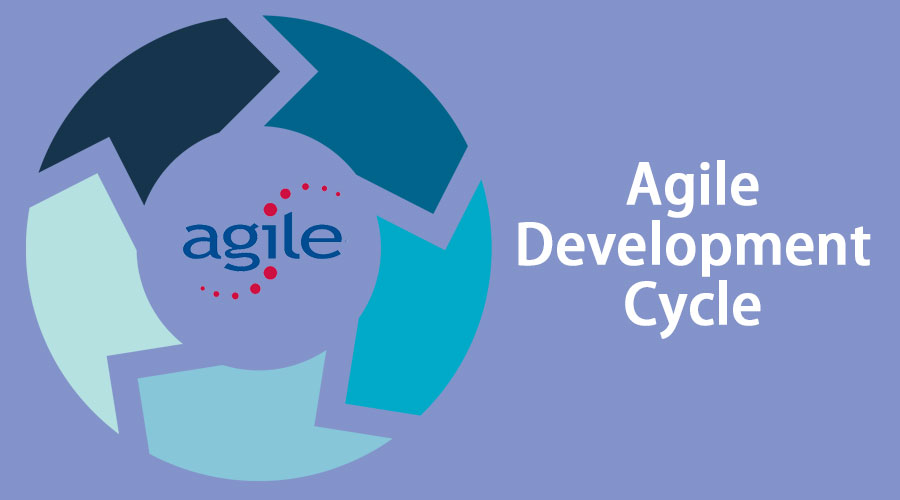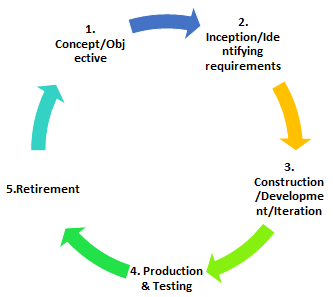Updated May 26, 2023
Introduction to Agile Development Cycle
The Agile Development cycle or Agile Software development life cycle is the methodology of implementing the agile project management methodology to the software development process. Agile Software Development Cycle is also known as the Iterative or Incremental Software development Life cycle as the software development is based on continuous learning from the iterations. Agile methodology is a method of implementing a set of planning and management techniques based on the iterative and incremental execution of tasks as per the project requirement. In addition, agile practices concentrate on teamwork by allowing teams to work on a project and to make modifications and changes during the software development to achieve the project’s objective efficiently.
Phases of Agile Development Cycle
The Agile development Life Cycle can be divided into 5 different phases:
1. Concept/Objective
In this phase, the objective of the software and how the user interface will appear are finalized based on the client’s requirements and interaction. It also defines the business opportunities and the time required to complete the project. Thus, this phase clarifies the client’s expectations related to the project.
2. Inception/Identifying Requirement
Once the project is finalized, initial requirements including:
- The team members (UI/UX designers and developers).
- Gathering the initial support and fund.
- Modeling the development using the architectural strategy and flow charts.
3. Construction/Development/Iteration
The development team starts developing the software based on the first iteration to produce a working product with minimum functionality at the end of the first sprint, which then undergoes continuous revisions and improvements until finalized.
The following steps are executed in this phase:
- Team association with the stakeholders/clients.
- Prioritizing and implementing the iterations and functionalities.
- Scrutinizing and developing each iteration/sprint.
- The regular release of working solutions.
- Testing after every step to assure quality.
4. Production & Testing
Before releasing the final product/software, the quality assurance team tests the software to detect defects, bugs, faults, or errors and record wins and losses. This phase also supports the ongoing software release and feedback from the client and the users. We guide the client and the users on how to use the software. This phase ends when the release is slated for retirement.
The various tasks performed in the production and testing phase are:
- Testing and debugging of the system.
- Finishing the system development and user documentation.
- Guiding and Training users.
- Deploy the System.
5. Retirement
This phase is all about the system decommissioning or system sun setting. We remove and replace old or legacy systems with new software, ensuring minimal impact on business operations and a smooth process flow.
There are different reasons for system release in the retirement phase, including:
- The release is no longer supported.
- The system has become obsolete.
- We must update the system to a newer version to enhance the business model.
Agile methodology concentrates on developing the right product with minimum cost and no error. The agile development cycle is all about continuously evolving and emerging the development cycle. We embrace changes until we meet the client’s expectations.
Below mentioned are some of the rewards of using Agile Methodology:
- Agreeable Methodology: The dynamic involvement, support, and cooperation make agile development teams much more pleasant for most people. Instead of hefty modules, lengthy reports, and long project plans, Agile concentrates on small workshops, sprints, task-oriented discussions, and effective time management for completing the project. The team members have the authority to make decisions to develop an efficient product. Thus, Agile Development Cycle helps build highly motivated, performance-oriented, highly cooperative teams.
- Transparency: In the agile process, we involve stakeholders/clients in every iteration throughout the development life cycle. They provide continuous constructive feedback and participate in review sessions. This involvement meets their expectations and adds transparency to the project development process.
- Anticipation and Timely Delivery: We pre-plan and thoroughly discuss the sprints and iterations to ensure we deliver the expected results within the projected time frame. The Agile Development Cycle showcases brilliant team spirit and the visible anticipation of team members in delivering the release.
- Calculated Costs and Schedule: As the Sprint is a fixed duration, the cost is predictable to the amount of work. By offering estimates to the client before each sprint, the client gains a clear understanding of the approximate cost of each feature. This understanding aids the client in making decisions for further actions.
Principles for Smooth Functioning of Software Development
Given below are the principles for the smooth functioning of software development:
1. Customer Satisfaction Through Early and Consistent Delivery: Meeting the client’s requirement is the top priority by delivering an effective solution as slated by the customer by minimizing the time required to complete the sprints.
2. Embraces Changes and Open for Improvements: Agile development accepts the suggestion, which is effective for the right product development. Thus, unlike some rigid strategies, agile development offers flexibility in the latter part of development.
3. Focused on Breaking the Hefty Chunk into Short Sprints: Agile functions by dividing the project into short-fix duration sprints to ensure timely delivery of the working solution to the client.
4. Great Collaboration Between the People and Developer: In Agile Development Cycle, stakeholders and the developers work closely to achieve success. Thus, Agile displays a brilliant association of people and technology.
5. Ensuring transparency using Face to Face Discussions: Face-to-face discussions are encouraged for constructive feedback and continuous improvements to meet the target expectations and quality assurance.
6. Producing Quality Product: The software/product undergoes rigorous quality testing before implementation to eliminate bugs and flaws for the smooth functioning of the business operations.
7. Sustainable Development: In Agile Development Cycle, work is done in short fixed duration bursts to ensure productivity and better outcomes. Developing the product at the right place is pivotal to achieving success in agile project management.
8. Providing the best Design and Excellent Technology: In Agile Development Cycle, refining code is not a compulsion as the code will improve automatically with every iteration. Scrum tools can further enhance the speed of the process, achieving more work in less time without compromising on quality.
Recommended Articles
This has been a guide to Agile Development Cycle. Here we discuss the 5 Phases of the Agile Development Cycle along with the principles for the smooth functioning of software development. You can also go through our other suggested articles to learn more –





